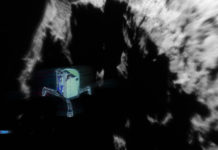The origin of Cosmic Rays have been much talked about and is still under the clouds of mystery. Though they have been mainly discovered to be originating outside the solar system, where do they really originate from is still debatable. So how and when were they discovered?
After the discovery of radiation by French physicist Henri Becquerel (1852–1908) in 1896, scientists believed atmospheric ionization (where an electron is stripped from an air molecule) occurred only from radioactive elements found in ground rocks or from radioactive gases.
Austrian physicist Victor Hess (1883–1964) found an additional source in 1912, when he strapped three electrometers into a balloon and measured atmospheric radiation at an altitude of about 15,000 feet (4,600 meters). He found an ionization rate about 4 times greater than at ground level. Hess could explain the variant observations only if a powerful source of radiation were penetrating the atmosphere from above.
Much later, in 1936, Hess received the Nobel Prize in physics for the discovery of what we now call cosmic rays. Physicists initially believed cosmic rays were gamma rays, high-energy radiation produced by radioactive decay.
Supernovae — exploding massive stars — are one important source of cosmic rays. Astronomers combined images made with the Hubble Space Telescope (red) and Chandra X- ray Observatory (blue) to create this portrait of the Crab Nebula (M1) in Taurus.

During the 1930s, however, experiments revealed that cosmic rays are mostly charged particles. In 1937, French physicist Pierre Auger (1899–1993) found that extensive particle showers (called air showers) occur when cosmic rays collide with particles high in the atmosphere, producing a cascade of electrons, photons, and muons (particles similar to electrons but 200 times as massive) that reach Earth’s surface.
In 1954, members of the Rossi Cosmic X- ray Group at the Massachusetts Institute of Technology in Cambridge made the first samplings of extensive air showers. The network of detectors at Harvard College Observatory produced much data on cosmic rays and their levels of energy. In Argentina, the Pierre Auger Observatory opened in 2003 and aims to detect extremely high-energy cosmic rays. This international project will include a northern component in southeastern Colorado. The particles under detection have as much energy as a tennis ball traveling at 340 mph (550 km/h), packed into the space of a single proton. Physicists have nicknamed them “Oh-my-God particles.”
The interstellar medium, gas and dust between the stars, produces cosmic rays that reach Earth. A pillar of gas and dust in the Eagle Nebula (M16) reveals the rich structure of the stuff that fills our galaxy. The following image is an amazing capture of the cold gas and dust captured by the Hubble Space Telescope. It was released by NASA by the name ‘Pillars of Creation’.

Aside from the Auger Observatory, other cosmic-ray research projects include HiRes at the University of Utah; Mariachi, a project of the National Science Foundation, Stony Brook University, and Brookhaven National Laboratory; and SLAC, at the Stan- ford Linear Accelerator. When the particles produced in air showers decay, three kinds of neutrinos result. Because neutrinos so rarely interact with other matter, most pass through Earth undetected. But ambitious detector projects now in operation are searching for neutrinos produced by cosmic-ray showers.
In 1998, the Super-Kamiokande detector in Japan found evidence of one type of neutrino changing into another “flavor.” By studying cosmic rays for several decades now, astronomers have begun to understand them. Astronomers categorize cosmic rays into four basic types. The first are those with low energies, called anomalous cosmic rays. They probably originate in the heliosheath, at the solar system’s edge, where the solar wind no longer has any effect.
Astronomers believe anomalous cosmic rays occur when electrically neutral atoms in the heliosheath are ionized and accelerated. However, when the Voyager 1 spacecraft passed into the inner edge of the heliosheath, it did not detect any such particle acceleration. So the jury is still out. The second type, galactic cosmic rays, flows into the solar system from other parts of the Milky Way. Astronomers believe supernovae produce most cosmic rays of this type.
In the aftermath of a supernova explosion, particles bounce repeatedly within the gaseous remnant and accelerate into cosmic rays. At some critical point, they escape into the galaxy. Third are the abundant cosmic rays that originate from the Sun. Most of these are protons, particles at relatively low energies. The intense magnetic fields at the Sun’s surface energize them.
The last kind are ultrahigh-energy cosmic rays, the type being sought by the Auger Observatory and other projects. These include the Oh-my-God particles. Scientists don’t yet know these particles’ origins, although researchers plan a number of experiments to try to understand them.
-end-




































